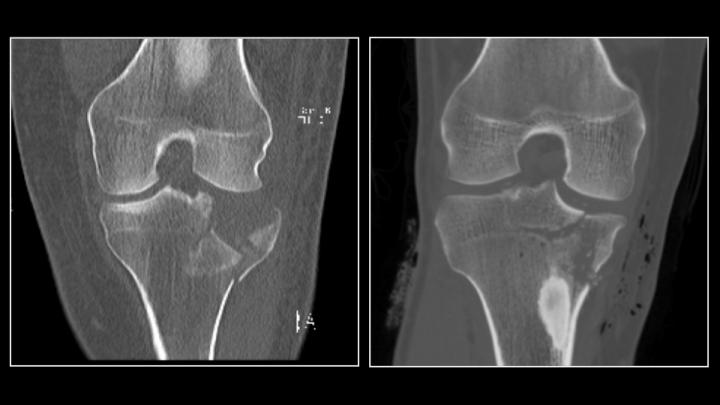Ultra-low dose CT scans successfully detect fractures

This is an ultra-low dose radiation CT scan of a fracture of the tibial plateau (left) compared to a conventional dose CT scan. Credit: NYU Langone MedicalCenter
Computed Tomography (CT) scans are one of the most frequently-used imaging tools in medicine. In fact, more than 72 million scans are performed each year to diagnose various medical conditions. But public health concerns persist about radiation exposure from these tests — especially when given to children and young adults. Now, researchers at NYU Langone Medical Center report in a new study that they successfully performed CT scans for joint fractures with one-fourteenth the amount of normal CT radiation — without compromising image quality or a surgeon's ability to effectively diagnose an injury.
Specifically, the researchers reduced the average amount of radiation from 0.43 msV to 0.03 msV, or down to the average dose given in a routine chest x-ray. Equally important, the researchers were able to accurately identify the presence of typical fractures 98 percent of the time.
“We have taken a frequently used and necessary imaging test and made it safer,” says lead study author Sanjit R. Konda, MD, assistant professor of orthopaedic surgery at NYU Langone and director of orthopaedic trauma at Jamaica Hospital Medical Center. “Providing patients with a CT scan with 14-times less radiation could have significant implications from a public health and safety standpoint.”
The findings are being presented Wednesday, March 2, at the 2016 American Academy of Orthopedic Surgeons (AAOS) Annual Meeting.
Radiation in CT Scans: A Public Health Concern
CT scans help diagnose medical conditions including broken bones, cancers, internal bleeding, or signs of heart disease. Yet, despite its prevalent use, medical societies and federal agencies have been increasingly trying to reduce the number of unnecessary scans due to radiation's link to an increased risk for cancer. While the overall risk is considered low, there is particular concern in performing CT scans on children. Approximately 600,000 head and abdominal CT scans are annually performed in children under 15.
In orthopaedic trauma, CT scans help diagnose injuries around a joint, particularly if the fracture involves the joint's surface. The scans also help clinicians assess joint displacement and aid in surgical planning to put the joint back in position. An X-ray, while a good initial screening tool, does not provide the same level of detail.
Protocol Put to the Test
Dr. Konda's team worked with radiologists from NYU Langone, led by study co-author Soterios Gyftopoulos, MD, an assistant professor of radiology, to reduce the amount of CT radiation while maintaining image quality. Together, they developed a protocol called REDUCTION (Reduced Effective Dose Using Computed Tomography In Orthopaedic Injury).
Previously, the group applied this protocol to examine air around a knee joint where infections easily could develop. Its application was so successful that the researchers set out to use the protocol to reduce radiation for traumatic joint fractures, such as those caused by a car accident or fall.
Between August 2014 and March 2015, 50 patients showing clinical symptoms of joint fractures received ultra-low dose radiation CT scans. Images from these ultra-low dose CT scans were compared to a sample of age-matched, similar fracture injuries where patients were evaluated with a standard CT scan.
The results were impressive: researchers achieved 98-percent sensitivity and 89 percent specificity with the ultra-low dose CT scans. In other words, if a person has a joint fracture, it would be detected on the ultra-low dose CT scan 98 percent of the time, while a negative finding – no fracture having occurred — was determined 89 percent of the time. Equally important, these findings were comparable to the conventional CT-scans (98 percent sensitivity and 85 percent specificity with occult fractures removed). Image quality was rated moderate to near perfect by the orthopaedic surgeons.
“The ability to perform ultra-low dose radiation CT scans without compromising image quality demonstrates the comprehensive capabilities of this protocol,” says senior study author Kenneth A. Egol, MD, professor of orthopaedic surgery and chief of the division of orthopaedic trauma surgery at NYU Langone. “Patients who undergo a traumatic injury or suspected fracture have enough to worry about. Our research makes radiation exposure among the least of their concerns.”
Next, the researchers will continue to follow-up patients who underwent the ultra-low dose CT scans to ensure patient outcomes haven't changed in the hopes of expanding the protocol to other departments.
###
In addition to Drs. Konda, Egol and Gyftopoulos, NYU Langone researchers included Abraham Goch, BS; Philipp Leucht, MD, PhD; Anthony Christiano, BA, and Gideon Yoeli, MD, provided support from Jamaica Hospital Medical Center.
Media Contact
All latest news from the category: Medical Engineering
The development of medical equipment, products and technical procedures is characterized by high research and development costs in a variety of fields related to the study of human medicine.
innovations-report provides informative and stimulating reports and articles on topics ranging from imaging processes, cell and tissue techniques, optical techniques, implants, orthopedic aids, clinical and medical office equipment, dialysis systems and x-ray/radiation monitoring devices to endoscopy, ultrasound, surgical techniques, and dental materials.
Newest articles

Time to Leave Home? Revealed Insights into Brood Care of Cichlids
Shell-dwelling cichlids take intense care of their offspring, which they raise in abandoned snail shells. A team at the Max Planck Institute for Biological Intelligence used 3D-printed snail shells to…

Smart Fabrics: Innovative Comfortable Wearable Tech
Researchers have demonstrated new wearable technologies that both generate electricity from human movement and improve the comfort of the technology for the people wearing them. The work stems from an…

Going Steady—Study Reveals North Atlantic’s Gulf Stream Remains Robust
A study by the University of Bern and the Woods Hole Oceanographic Institution in the USA concludes that the ocean circulation in the North Atlantic, which includes the Gulf Stream,…



